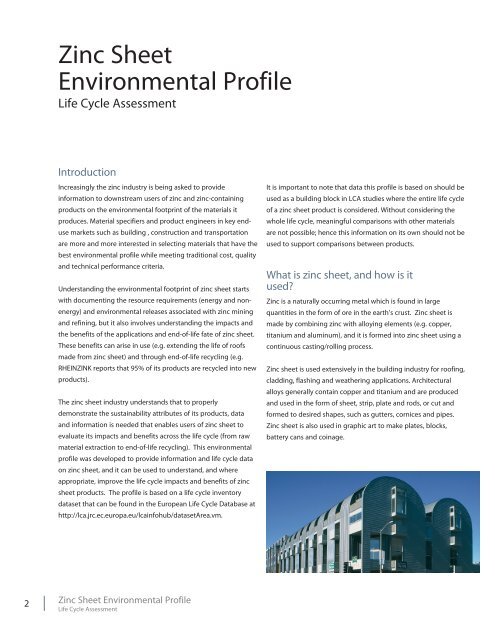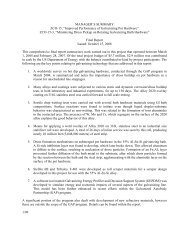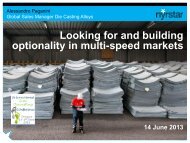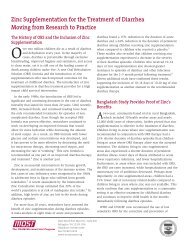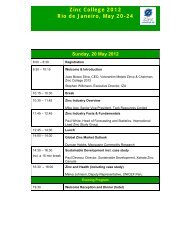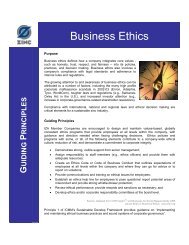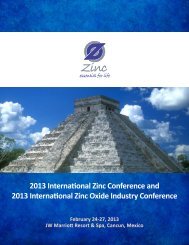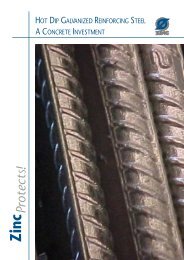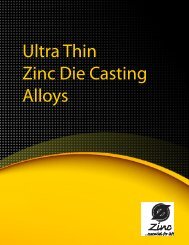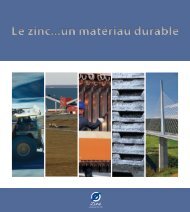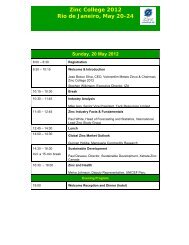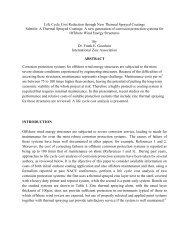Zinc Sheet Environmental Profile - Life Cycle Assessment
Zinc Sheet Environmental Profile - Life Cycle Assessment
Zinc Sheet Environmental Profile - Life Cycle Assessment
You also want an ePaper? Increase the reach of your titles
YUMPU automatically turns print PDFs into web optimized ePapers that Google loves.
<strong>Zinc</strong> <strong>Sheet</strong><br />
<strong>Environmental</strong> <strong>Profile</strong><br />
<strong>Life</strong> <strong>Cycle</strong> <strong>Assessment</strong><br />
Introduction<br />
Increasingly the zinc industry is being asked to provide<br />
information to downstream users of zinc and zinc-containing<br />
products on the environmental footprint of the materials it<br />
produces. Material specifiers and product engineers in key enduse<br />
markets such as building , construction and transportation<br />
are more and more interested in selecting materials that have the<br />
best environmental profile while meeting traditional cost, quality<br />
and technical performance criteria.<br />
Understanding the environmental footprint of zinc sheet starts<br />
with documenting the resource requirements (energy and nonenergy)<br />
and environmental releases associated with zinc mining<br />
and refining, but it also involves understanding the impacts and<br />
the benefits of the applications and end-of-life fate of zinc sheet.<br />
These benefits can arise in use (e.g. extending the life of roofs<br />
made from zinc sheet) and through end-of-life recycling (e.g.<br />
RHEINZINK reports that 95% of its products are recycled into new<br />
products).<br />
The zinc sheet industry understands that to properly<br />
demonstrate the sustainability attributes of its products, data<br />
and information is needed that enables users of zinc sheet to<br />
evaluate its impacts and benefits across the life cycle (from raw<br />
material extraction to end-of-life recycling). This environmental<br />
profile was developed to provide information and life cycle data<br />
on zinc sheet, and it can be used to understand, and where<br />
appropriate, improve the life cycle impacts and benefits of zinc<br />
sheet products. The profile is based on a life cycle inventory<br />
dataset that can be found in the European <strong>Life</strong> <strong>Cycle</strong> Database at<br />
http://lca.jrc.ec.europa.eu/lcainfohub/datasetArea.vm.<br />
It is important to note that data this profile is based on should be<br />
used as a building block in LCA studies where the entire life cycle<br />
of a zinc sheet product is considered. Without considering the<br />
whole life cycle, meaningful comparisons with other materials<br />
are not possible; hence this information on its own should not be<br />
used to support comparisons between products.<br />
What is zinc sheet, and how is it<br />
used?<br />
<strong>Zinc</strong> is a naturally occurring metal which is found in large<br />
quantities in the form of ore in the earth’s crust. <strong>Zinc</strong> sheet is<br />
made by combining zinc with alloying elements (e.g. copper,<br />
titanium and aluminum), and it is formed into zinc sheet using a<br />
continuous casting/rolling process.<br />
<strong>Zinc</strong> sheet is used extensively in the building industry for roofing,<br />
cladding, flashing and weathering applications. Architectural<br />
alloys generally contain copper and titanium and are produced<br />
and used in the form of sheet, strip, plate and rods, or cut and<br />
formed to desired shapes, such as gutters, cornices and pipes.<br />
<strong>Zinc</strong> sheet is also used in graphic art to make plates, blocks,<br />
battery cans and coinage.<br />
2 <strong>Zinc</strong> <strong>Sheet</strong> <strong>Environmental</strong> <strong>Profile</strong><br />
<strong>Life</strong> <strong>Cycle</strong> <strong>Assessment</strong>


